India's ancient and mysterious 'dwarf' chambers
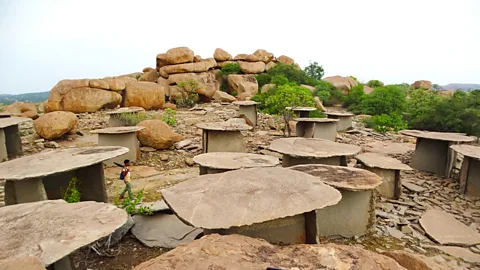 Bansari Kamdar
Bansari KamdarNearly 1,000 Tolkien-esque megalithic chambers dot southern India's "Hill of the Dwarfs", and locals believe they were created by a supernatural race of "small people".
At first glance, Hire Benkal might be mistaken for any other village nestled in Karnataka's lush interior. Surrounded by rocky hillocks, mango groves, small brick kilns and fields fed by a nearby canal, it exudes a languid, laid-back charm characteristic of rural South India.
However, a 90-minute hike up one of the ridges flanking the village brought me to Moryar Gudda, or the "Hill of the Dwarfs", as its name means in the local Kannada language. Here, scattered across a granite-strewn plateau were nearly 1,000 prehistoric megalithic structures that have stood for more than 2,500 years. It's a startling sight: nearly as far as the eye can see, rows of giant stone chambers resembling houses and stone circles stretch across the landscape, forming one of the oldest and largest necropolises in India.
The trek felt like stepping into a Tolkien tale. Massive boulders teetered precariously on top of one another, creating natural sculptures that seemed on the verge of tipping over at any moment but have somehow stood firm for millennia. Some formations housed rock shelters with red ochre paintings dating from 700-500 BCE, many still vivid with scenes of creatures resembling cattle and boar whose meanings have long been lost to time.
Historians believe the formations were created as an ancient burial or commemorative site. However, its exact purpose remains a mystery.
 Creative Commons
Creative CommonsStonehenge may be the world's most famous megalithic monument, but tens of thousands of other such sites are scattered across the planet. While Europe counts more than 35,000 of these prehistoric constructions, only 3,000 or so have been documented in India. But by coming face to face with Hire Benkal's ancient, enigmatic structures and the painted scenes of battle axe-wielding horseback riders, spear-clutching hunters, and deified deer, peacocks and other animals, adventurous travellers can get a sense of how early Indian societies lived, worshipped and were laid to rest.
The Hire Benkal archaeological site spans roughly 20 hectares, with an east-west orientation that suggests ceremonial or astronomical significance. Dominating the landscape are giant rectangular megalithic tombs with large capstones and side walls, known as dolmen. Many of the larger dolmen are clustered around a wide, shallow water basin at the top of the hill. Experts believe this basin likely began as a natural rock pool and may have been expanded over time as ancient Indians quarried to construct additional megaliths.
That morning, white and pink water lilies floated in bloom across the small pond, evoking the delicate beauty of a Monet painting.
"It must have been a very important site for several centuries because it cannot have all been done in one time," said Srikumar Menon, an architect and associate professor at the National Institute of Advanced Sciences who has studied Hire Benkal and many other megaliths around the country.
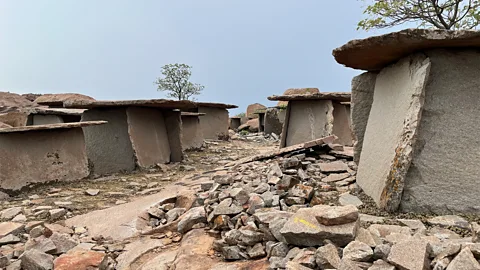 Bansari Kamdar
Bansari KamdarAccording to local lore, the site's dolmen weren't built by humans, but by an extinct species of dwarfs known as the "moriyars". These supernatural beings were said to possess immense strength and engineering prowess. As Chandrashekar Anegundi, a local naturalist who led our trek, explained: perfectly cut circular portholes on some of the dolmen have led nearby villagers to believe these legends, as the shapes are so precise that they're thought to be too sophisticated for early sculptors.
"The villagers here believe moriyars were very short people and they were wiped out in a rain of fire," said Anegundi, who remains sceptical. "If they were so small, how could they have lifted these big stones?"
During his research, Menon encountered similar legends referring to an ancient race of "small people" who allegedly constructed megalithic sites across southern India, such as at Moribetta and Morikallu nearby in Karnataka, Sanna Moriyara Thatte in Telanganaand Moral Parai in Tamil Nadu. He speculates that such folklore could be a far-reaching cultural memory of ancient Indians recalling an extinct human-like species, akin to Homo floresiensis, the so-called "hobbit" species discovered in Indonesia who likely lived alongside Homo sapiens 60,000 to 100,000 years ago.
"We know the megalith builders were humans like us," Menon said. "But stories of these little people persist across the region."
Despite its archaeological importance and historical intrigue, Hire Benkal remains largely unknown beyond southern India and overshadowed by the nearby Unesco World Heritage-listed temples and monuments of Hampi. The erstwhile medieval capital of the Vijayanagara Empire, located just 42km south of the megalithic site and renowned for its stunning ruins and grand temples, attracts thousands of tourists and devotees annually.
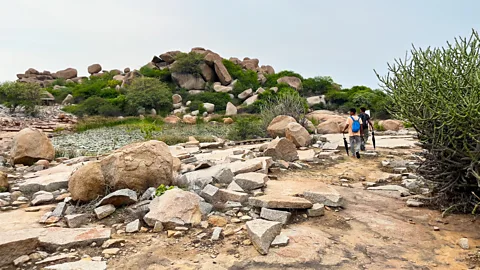 Bansari Kamdar
Bansari KamdarMeanwhile, local guides report that only about 20 to 30 intrepid travellers venture to Hire Benkal some months, with a peak of roughly 100 arriving during the cooler tourist season from October to February. By comparison, Stonehenge's 83 standing stones lure more than one million visitors annually.
"This place has never been promoted, not even among people in nearby cities like Bengaluru," says Disha Ahluwalia, an archaeologist and research scholar at MSU Baroda. "And yet, it deserves so much more attention… A lot of effort has been made by ancient humans to build them; we need to make double the effort to preserve them. And first we need to document them."
As for the legend of the moriyas, Ahluwalia said the discovery of the site by British colonial officers in 1835 and their dismissive attitude towards ancient and rural Indian communities' technological prowess likely also fed into this myth.
"The officers were going to these sites without even knowing the culture. Even if the megaliths were discovered, they were not very well known. They were simply [seen as] stone slabs," she said.
In recent years, some of Hire Benkal's megalithic structures have fallen victim to vandalism, cattle herders and treasure hunters who dig beneath the dolmen in search of rumoured riches. The overgrowth of plants, the ravages of time and the lack of preservation have also taken a toll on the ancient burial grounds.
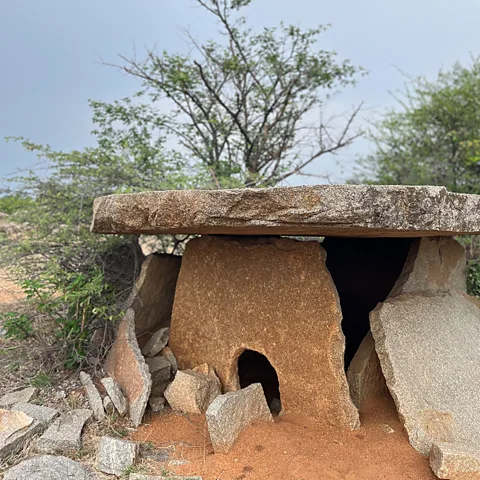 Bansari Kamdar
Bansari Kamdar"It's a fragile site… people often vandalise what they don't understand," said Meera Iyer, convener at the Indian National Trust for Art and Cultural Heritage Bengaluru, which has been actively working to include Hire Benkal as a Unesco World Heritage site. A successful nomination could provide international recognition, government funding and improved conservation measures. Local communities could also benefit from more visibility and visitors.
More like this:
• What did Stonehenge sound like?
"But tourism is a double-edged sword," Iyer warned, noting that too much of it without appropriate protection could cause the site to fall into further decay. "What's needed is interpretation, education and better regulation."
While Hire Benkal's future remains unclear, one thing is certain: it's a hauntingly beautiful site. As rain clouds gathered over the Deccan plateau, the land seemed to have burst with life. On the walk up, shy songbirds flitted through the bushes. Peacocks were in full regalia, their iridescent tails fanned wide as monsoon heralded mating season. Rock agamas basked lazily on sun-warmed granite, while herds of goats meandered through the underbrush. Anegundi pointed out golden amaltas trees blooming between craggy outcrops.
"It's a paradise, for birds and for us," he said, collecting a few seed pods from the trees.
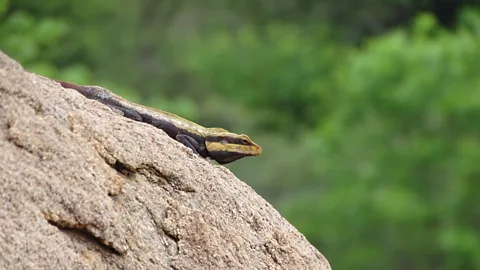 Chandrashekar Anegundi
Chandrashekar AnegundiAt Hire Benkal, the natural and the supernatural blend together. Standing at the summit, dolmen stretched out in orderly rows across the rocky ridge, boxes of stone holding the secrets of a forgotten people.
While we may never know exactly why our ancestors constructed these chambers, it is clear that this place mattered deeply to those who once lived here. For now, it remains one of India's most intriguing open-air secrets – a prehistoric monument hiding in plain sight.
--
If you liked this story, sign up for The Essential List newsletter – a handpicked selection of features, videos and can't-miss news, delivered to your inbox twice a week.
